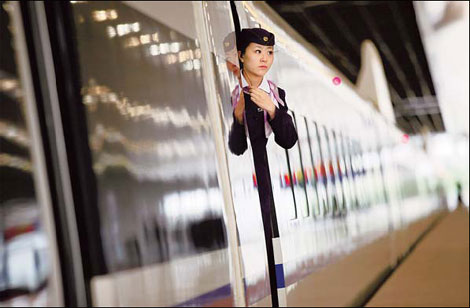Tech
Huge road, rail boost in pipeline
By Wang Xiaotian (China Daily)
Updated: 2010-11-09 07:58
 |
Large Medium Small |
|
An attendant on the first bullet train of a new high-speed railway linking Shanghai with Hangzhou prepares to welcome guests before departing for Hangzhou. China has spelled out massive plans to build high-speed railways. Provided to China Daily |
Next five years 'critical period' for nation to build transport network
BEIJING - China will set up an 85,000-km national freeway network and a 40,000-km high-speed railway network during the 12th Five-Year Plan (2011-2015), said a leading official from the National Development and Reform Commission (NDRC).
The freeway network will cover all cities with a population of at least 200,000, while high-speed railways will link cities with more than 500,000 residents, said Wu Xiao, deputy director-general of the NDRC's basic industries department.
"The government has eased transport capacity pressures and virtually solved many bottleneck problems... regarding economic and social development," he said at a regional workshop on transport infrastructure in Beijing jointly held by the central government and the Asian Development Bank (ADB).
China's annual investment in transport fixed assets and highway construction now exceeds 1.1 trillion yuan ($165 billion), of which 967 billion yuan was invested in road construction.
Wu said that, as a proportion of the overall investment, spending on railways will increase by a large margin while the amount expended on road construction will fall.
"Although China has made great improvements in transport development, the country's gross quantity of infrastructure in this respect remains insufficient, and transport in western areas is still underdeveloped," said Li Yong, deputy minister of finance.
The next five years is a critical period for China to promote transport infrastructure construction together with other Asian countries, he added.
Transport infrastructure has played a critical role in helping to boost growth and cut poverty in the Asia-Pacific region, said ADB Vice-President (Finance and Administration) Bindu Lohani.
"It is an important determinant of economic growth, job creation and poverty reduction," Lohani said.
"Improvements in transport infrastructure reduce the costs of transportation and improve its quality. This strengthens economic performance by making goods and services more competitive and by stimulating growth in trade."
The ADB has called on Asian economies to strengthen their infrastructure investment through an effective financing framework to achieve higher and more sustainable growth.
The bank said that as much as $750 billion will have to be invested annually in infrastructure across the region by 2020. This means that about $8.25 trillion will be invested in that period in national and cross-regional infrastructure projects.
The required infrastructure investment for pan-Asian connectivity in the transport, communications and energy sectors in the next 10 years is expected to produce income gains of about $13 trillion throughout Asia, the bank said.
Lohani said that while the benefits of building better transport infrastructure were commonly accepted, these present significant financing challenges for ADB's developing member economies. He suggested that many governments increase their investment in transport infrastructure, and at the same time encourage the private sector to play a bigger role.
He also stressed that "greener" and more efficient urban transport needs to be inserted in city planning and policymaking within the wider context of creating more livable cities.
China Daily
